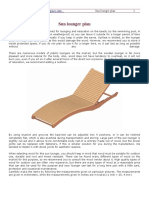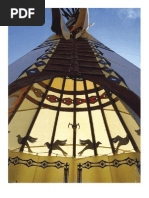Planos de Hamaca de Jardín
Planos de Hamaca de Jardín
Uploaded by
kevineliCopyright:
Planos de Hamaca de Jardín
Planos de Hamaca de Jardín
Uploaded by
kevineliOriginal Title
Copyright
Share this document
Did you find this document useful?
Is this content inappropriate?
Copyright:
Planos de Hamaca de Jardín
Planos de Hamaca de Jardín
Uploaded by
kevineliCopyright:
Page 1 of 21
Garden Hammock with Stand
Hammock was developed by native inhabitants of tropical regions because of simple reason to be elevated above the ground during the sleep to avoid stings and bites of various creatures on the ground like ants and snakes. Spanish colonists noted use of the hammock by Native Americans and quickly introduced it for use. Christopher Columbus brought the hammock to Europe, and the Europeans quickly realized its other practical value, aside for sleeping in the woods. At the end of 16th century hammock was adopted for use on sailing ships, because the hammock save he space and, unlike the ordinary bed, swinging together with the ship, so the sailors did not fell out of it. If we know that beds on ships had several bunks, we can only presume how useful the hammock to the sailors was. Today, use of the hammocks is widely accepted by the campers, forest scientists and explorers, as well as for the relaxation and for the rest. It can often be seen on the beach, by the pool, in the country-houses and gardens. For additional comfort, the hammock can have pillows or mosquito net. Hammock types: There are several types of hammock: Spreader bar hammock, Mayan hammock, Brazilian hammock, Naval hammock, Venezuelan (Jungle) hammock, Travel hammock... Each type is distinctive and has its own advantages and disadvantages. Hammocks are made in various dimensions, patterns, colors and out of different types of materials, like: natural or synthetic fabric, string, netting...
Many types of hammocks can be purchased in stores or via internet and the common thing for all of them is that they have to be attached between two supports. For supports you can use two trees at a suitable distance, tree and wall of the house, the supports buried into the ground... These are the simplest solutions, but their shortage is that they are fixed, and sometimes it is very difficult to find and use two existing supports in the yard or a garden. If there is no suitable spot, where you could attach your hammock, then the hammock stand is the best solution for you. The hammock
Page 2 of 21
stand can be purchased, or you can make it by yourself. There are many types of the hammock stands that you can buy or make: metal hammock stand, wooden hammock stand, arc hammock stand, classic frame hammock stand. We decided to present you an elegant wooden hammock stand of a very simple design, which can easily be made even in a less equipped workshops. Connections between the parts are made with fasteners, so it can be quickly disassembled and stored in a protected, dry place during periods when not in use. Many hammocks come in a variety of types and sizes, so it is very difficult to design a universal hammock stand. Dimensions of the hammock stand depend on the size of the hammock, and whether hammock have or do not have spreader bars. Dimensions of the hammock stand also depend upon individual wishes and possibilities: depending on the available space in the yard or terrace and whether you want the hammock stand to dominate the garden or not... Our goal was to offer you the hammock stand plan with the wooden structure presented, and your task is to adjust it to your preferences. Connection between dimensions of the hammock stand and the hammock dimensions: There are two types of hammocks with or without spreader bars. Spreader bars are the wood or metal bars on each end of the hammock bed, spreading its width and allowing for easy access. In most cases the hammock stand fits to one or another variant of the hammock, but hammock without the spreader bars has higher curvature and must be attached higher, so the hammock stand construction has to be slightly different. An important fact for the hammock hanging is the distance between the hanging points. For the hammocks with spreader bars, distance between hanging points should be equal to the overall length of the hammocks. If the distance between the hanging points on the hammock stand is larger, you will have to lengthen the overall length of the hammocks on both ends with the ropes or chains. The minimum hanging distance for hammocks without spreader bars is two thirds of the overall length of the hammock. Of course, these are just ours recommendations, which can be freely changed as needed. If the hanging distance is lesser than 2/3, then the curvature of hammock is higher and you will have to set the hanging points higher off the ground; if it is higher than 2/3, then the curvature is lesser and the hanging points can be closer to the ground. These facts clearly show the difference in the lying comfort, so it all depends on your wishes. Distance off the ground for the hanging points should be 1,2 1,5m (4-5 feet) for the hammocks with spreader bars, and 1,8 2,4m (6-8 feet) for the hammocks without spreader bars. We recommend that you always use a hammock stand if you have a hammock with spreader bars. If you have a hammock without spreader bars (Mayan or Brazilian hammocks...), you can hang it on a hammock stand, or between the trees, etc. but respect the criteria of the hanging points distances that we specified, otherwise you will most likely find yourself dipping so deep that you will connect with the ground. As you can see in the hammock stand plan, the dimensions that we offer are adjusted for the simplest version of the hammock, which you can see on the picture of the finished hammock stand. If you decide to buy a hammock, you may need to change dimensions of a hammock stand to meet the criteria for the hammock hanging we mentioned above, since there are hammocks of various sizes and types on the market. The principle is as follows: based on overall length of your hammock, you can calculate the length of the Horizontal part (part 3); and based on the type of hammock you bought, you can determine the hanging points height. We hope that the criteria we have specified will be useful for these calculations. On the following picture you can see the process of the Horizontal part length (part 3) calculation.
Page 3 of 21
Hammock stands can be made of different kinds of wood such as cypress, cedar, teak, eucalyptus and other hardwoods suitable for outdoor use. If you plan to keep the hammock outdoor, you can also use pressure treated wood, or you can protect wood with some oil or varnish. Depending upon the kind of wood you will use to make hammock stand, where you plan to set it and what climatic conditions you live in, you will need to devote more or less attention to the final processing of wood and the wood treatment. In the warm climate with more sunshine, you will need to treat the wood more frequently. If your wooden hammock stand will be exposed to the elements, it will require regular sanding with fine sandpaper, and treatment with some of the products for the wood protection, after each sanding. There are plenty products on the market, like linseed oil, mineral oil, etc. If you plan to keep the hammock in direct sunlight, it is wise to avoid fabric and ropes made of natural materials. Cotton and other natural materials are subject to fungus attack, so you should use synthetic fabric and ropes for this purpose. It can be quite tricky to get in and out of hammock with the hammock stand. If some older person intends to use the hammock, it will be a good idea, to be always around to help. Children should be supervised at all the time when using a hammock to avoid and accidental entanglement in the ropes of the hammock or falls from hammock or construction of the hammock stand. Unlike the metal hammock stands, the wooden ones are expensive, but they are far more stable because of their size and weight. And of course, the wooden hammock stands are much more beautiful. PLEASE, CHECK THE ORIGIN OF THE PARTICULAR PIECES OF WOOD YOU WANT TO PURCHASE for hammock stand making since most of the wood species suitable for the outdoor use are CRITICALLY ENDANGERED in their natural habitats because of the uncontrolled harvesting for commercial use. Make sure that wood you want to purchase do not belong to the endangered species, and does it come from the plantations, to avoid unwonted contribute to the devastation of life on earth. The measurements are given in millimeters, while the measurements given in inches are in brackets (1 inch = 25, 4 mm).
Page 4 of 21
Parts List
Page 5 of 21
Assembly Drawing
Page 6 of 21
Page 7 of 21
Page 8 of 21
Page 9 of 21
Page 10 of 21
Page 11 of 21
Page 12 of 21
Page 13 of 21
Page 14 of 21
Assemblage Instruction
1. Put a tenon of the Pillar (item 2) into mortise of the Paw (item 1).
Drill the hole with diameter 10mm through both items and fasten it using standard parts: Washer D10mm (item 4), Lock Washer D10mm (item 5), Hexagon Nut M10 (item 6) and Hexagon Head Bolt M10x140mm (item 7).
Page 15 of 21
Make the two of these subassemblies.
Page 16 of 21
2. Put the Horizontal (item 3) between the two subassemblies made in the previous step and drill the holes with diameter 10mm through it and through both subassemblies.
Fasten all items and subassemblies together using standard parts: Washer D10mm (item 4), Lock Washer D10mm (item 5), Hexagon Nut M10 (item 6) and Hexagon Head Bolt M10x140mm (item 7).
Page 17 of 21
3. Lean the Support (items 8) on the subassembly made in the previous step and drill the holes with diameter 8mm through items and subassembly.
Page 18 of 21
Fasten all items and subassembly with standard parts: Washer D8mm (item 9), Lock Washer D8mm (item 10), Hexagon Nut M8 (item 11) and Hexagon Head Bolt M8x130mm (item 12).
With this step you have finished making the Stand for Hammock.
Page 19 of 21
All you need to do now is to hang the Hammock on the Stand. You can purchase the Hammock in specialized stores, but we recommended making one of your own, because it is quite easy to make it using the Bar (items 13), Hammock (item 14) and Rope (item 15). Be careful to use thick and firm canvas and strong sewing threads.
Of course, the same goes for the rope it has to be enough thick to hold your weight.
Page 20 of 21
Page 21 of 21
You might also like
- Planos de Juguete de Madera, Perrito en AutoDocument15 pagesPlanos de Juguete de Madera, Perrito en Autokevineli100% (1)
- Electric Scooter PlansDocument6 pagesElectric Scooter PlansJim88% (8)
- Garden Hammock With StandDocument19 pagesGarden Hammock With StandbrasilgabrielcostaNo ratings yet
- Rede Madeira PDFDocument21 pagesRede Madeira PDFJOSE WERBSON SILVANo ratings yet
- Garage StorageRDocument6 pagesGarage StorageRHenrique Rampazzo100% (3)
- Build Rabbit Hanging CagesDocument9 pagesBuild Rabbit Hanging CagesProfessional RabbitryNo ratings yet
- Sun Lounger Plan: Project From 1Document20 pagesSun Lounger Plan: Project From 1Luis CabaçoNo ratings yet
- Classic Workbench Notes BC1216Document27 pagesClassic Workbench Notes BC1216Docus Pocus100% (1)
- How To Build A TreehouseDocument1 pageHow To Build A Treehouseladyanita22No ratings yet
- Woodshop Storage Solutions: 16 Projects for Maximizing Your WorkspaceFrom EverandWoodshop Storage Solutions: 16 Projects for Maximizing Your WorkspaceNo ratings yet
- How To Make Den Traps PDFDocument7 pagesHow To Make Den Traps PDFterrencebellesNo ratings yet
- Wood Trellis ArborDocument32 pagesWood Trellis Arborصبا باسلNo ratings yet
- Pallet Wood Armchair For Home and Garden: InstructablesDocument16 pagesPallet Wood Armchair For Home and Garden: InstructablesBenito Moreno RomeroNo ratings yet
- Gadget Building 2016Document36 pagesGadget Building 2016Kelvin MsafiriNo ratings yet
- Macrame for Home Decor: 40 Stunning Projects for Stylish DecoratingFrom EverandMacrame for Home Decor: 40 Stunning Projects for Stylish DecoratingRating: 5 out of 5 stars5/5 (1)
- Tipi Setup Catalog12 V6.0Document31 pagesTipi Setup Catalog12 V6.0victorNo ratings yet
- Low-Cost Compost Bins PDFDocument2 pagesLow-Cost Compost Bins PDFreza.salimpour526No ratings yet
- Router Repair of Soundboard Cracks: Using The Spurlock Specialty Tools Carbide Router Bit and Router BaseDocument10 pagesRouter Repair of Soundboard Cracks: Using The Spurlock Specialty Tools Carbide Router Bit and Router BaselazarNo ratings yet
- Backyard Building Treehouses, Sheds, Arbors, Gates, and Other Garden Projects by Stiles Jean, Stiles David. (z-lib.org)Document157 pagesBackyard Building Treehouses, Sheds, Arbors, Gates, and Other Garden Projects by Stiles Jean, Stiles David. (z-lib.org)zajacbogguslawNo ratings yet
- A Long-Term Survival Guide - How To Make Den TrapsDocument7 pagesA Long-Term Survival Guide - How To Make Den Trapsbuckonbeach100% (5)
- Family Handyman Big Book of ProjectsFrom EverandFamily Handyman Big Book of ProjectsFamily HandymanNo ratings yet
- Carving Creative Walking Sticks and Canes: 13 Projects to Carve in WoodFrom EverandCarving Creative Walking Sticks and Canes: 13 Projects to Carve in WoodNo ratings yet
- Foldable Hanging Balcony BarTableDocument19 pagesFoldable Hanging Balcony BarTableNijaz HadzicNo ratings yet
- Hugelkultur: The Ultimate Raised Garden BedsDocument23 pagesHugelkultur: The Ultimate Raised Garden BedsDaniel Pop100% (2)
- Buick Yip Dummies - Read MeDocument11 pagesBuick Yip Dummies - Read MeAndrew ChristenburyNo ratings yet
- PROJECTS AND PRACTICAL TECHNIQUES YOU SHOULD APPLY: A Comprehensive Guide to Mastering Essential Skills and Executing Successful Projects (2024)From EverandPROJECTS AND PRACTICAL TECHNIQUES YOU SHOULD APPLY: A Comprehensive Guide to Mastering Essential Skills and Executing Successful Projects (2024)No ratings yet
- Philip Chandler: How To Build A Simple Top Bar HiveDocument43 pagesPhilip Chandler: How To Build A Simple Top Bar HivebajaczanNo ratings yet
- HowtomakeabatboxDocument1 pageHowtomakeabatboxElHondoNo ratings yet
- Build A Pergola. Mitre 10Document12 pagesBuild A Pergola. Mitre 10John EvansNo ratings yet
- Tipi Construction - Instructions For Setting Up A Sioux TipiDocument32 pagesTipi Construction - Instructions For Setting Up A Sioux Tipihbpr9999100% (1)
- How To Build A Bomb Shelter-1Document9 pagesHow To Build A Bomb Shelter-1dmac27100% (2)
- Beach ChairDocument48 pagesBeach Chairjomavia100% (1)
- Bamboo Facts001Document12 pagesBamboo Facts001Bai AzharNo ratings yet
- Beach ChairDocument48 pagesBeach ChairEmilian BalutaNo ratings yet
- DIDGERIDOODocument7 pagesDIDGERIDOOJøjø TripNo ratings yet
- Tactical HomesteadingA1Document9 pagesTactical HomesteadingA1hazard12350% (2)
- Čamac Od KedraDocument58 pagesČamac Od KedraБ. А.100% (1)
- Build Coaching Inn and Stables WHFBDocument13 pagesBuild Coaching Inn and Stables WHFBLuis Júpiter Franco Martínez100% (2)
- DIY Bag Manual For Home GardeningDocument14 pagesDIY Bag Manual For Home GardeningChris Sealey100% (2)
- Diy Crafts: 27 Outstanding Art Projects and Homemade Gift Ideas for Simple Things to Make at Home for the Summer to Surprise Your Family and FriendsFrom EverandDiy Crafts: 27 Outstanding Art Projects and Homemade Gift Ideas for Simple Things to Make at Home for the Summer to Surprise Your Family and FriendsRating: 2 out of 5 stars2/5 (1)
- Build Yourself A Portable Home A Mongolian YurtDocument90 pagesBuild Yourself A Portable Home A Mongolian YurtFranchesca Cerda100% (2)
- The Complete Book of Birdhouse Construction for WoodworkersFrom EverandThe Complete Book of Birdhouse Construction for WoodworkersRating: 1 out of 5 stars1/5 (1)
- A Long-Term Survival Guide - Make A Survival StaffDocument9 pagesA Long-Term Survival Guide - Make A Survival Staffbuckonbeach100% (8)
- Flat Top Arbor With LatticeDocument40 pagesFlat Top Arbor With Latticeصبا باسلNo ratings yet
- Different Types of Knuckle HingesDocument14 pagesDifferent Types of Knuckle HingesGiNo ratings yet
- Bird HousesDocument146 pagesBird HousesAnonymous VbzFdYz100% (4)
- Woodcraft: A Guide to Camping and SurvivalFrom EverandWoodcraft: A Guide to Camping and SurvivalRating: 4.5 out of 5 stars4.5/5 (2)
- Open-Back Broadband Absorber Building Guide (Acoustic Panels) v1.5Document14 pagesOpen-Back Broadband Absorber Building Guide (Acoustic Panels) v1.5Churchil Meneer NaudéNo ratings yet
- Easy to Build Birdhouses - A Natural Approach: Must Know Info to Attract and Keep the Birds You WantFrom EverandEasy to Build Birdhouses - A Natural Approach: Must Know Info to Attract and Keep the Birds You WantRating: 3 out of 5 stars3/5 (1)
- 5 Awesome Bunker Plans On A BudgetDocument42 pages5 Awesome Bunker Plans On A BudgetAntonella DiSatana100% (2)
- Screw It!: Traditional Male Skills That Every Woman Should KnowFrom EverandScrew It!: Traditional Male Skills That Every Woman Should KnowNo ratings yet
- Professional Router Table PDFDocument17 pagesProfessional Router Table PDFhightecrebelNo ratings yet
- Planos de Juguete de Madera, Carrito AntiguoDocument9 pagesPlanos de Juguete de Madera, Carrito AntiguokevineliNo ratings yet
- Planos para Rack Portabotellas de VinoDocument12 pagesPlanos para Rack Portabotellas de Vinokevineli100% (1)
- Planos de Juguete de Madera, Autobús EscolarDocument9 pagesPlanos de Juguete de Madera, Autobús Escolarkevineli100% (1)
- Planos para Servilleteros de MaderaDocument5 pagesPlanos para Servilleteros de Maderakevineli100% (1)
- Planos de Falsa EscuadraDocument6 pagesPlanos de Falsa Escuadrakevineli0% (1)
- Planos de Restirador para Dibujo Técnico (Drafting Board)Document18 pagesPlanos de Restirador para Dibujo Técnico (Drafting Board)kevineli100% (5)
- Planos de Tablas de Madera para CocinaDocument4 pagesPlanos de Tablas de Madera para CocinakevineliNo ratings yet
- Wall Ladder With BedDocument21 pagesWall Ladder With Bedkevineli100% (1)
- Makaze Za Secenje LimaDocument14 pagesMakaze Za Secenje LimaDejan VučićevićNo ratings yet
- Planos para Mesa y Bancas de Jardín o TerrazaDocument57 pagesPlanos para Mesa y Bancas de Jardín o Terrazakevineli50% (2)
- Planos de Cascanueces de Madera Redondo.Document9 pagesPlanos de Cascanueces de Madera Redondo.kevineliNo ratings yet
- Planos para Caballito de MaderaDocument10 pagesPlanos para Caballito de MaderakevineliNo ratings yet
- Planos de Platillo de Madera para Aperitivos y Frutos SecosDocument5 pagesPlanos de Platillo de Madera para Aperitivos y Frutos SecoskevineliNo ratings yet
- Incline Lever RowDocument38 pagesIncline Lever RowkevineliNo ratings yet
- Planos para Plato Redondo para PanDocument3 pagesPlanos para Plato Redondo para PankevineliNo ratings yet
- Ship WheelDocument18 pagesShip Wheelkevineli100% (1)
- Quincho ModelDocument1 pageQuincho ModelkevineliNo ratings yet
- Preacher CurlDocument31 pagesPreacher CurlkevineliNo ratings yet
- Banco de GimnasioDocument46 pagesBanco de Gimnasiokevineli100% (3)
- Scroll BenderDocument23 pagesScroll Benderkevineli80% (5)
- Scroll Bender ManualDocument20 pagesScroll Bender Manualkevineli100% (4)
- Torneando Pulseras de MaderaDocument2 pagesTorneando Pulseras de MaderakevineliNo ratings yet
- Wonders in WoodDocument38 pagesWonders in WoodttkffNo ratings yet
- Salero y PimenteroDocument11 pagesSalero y PimenterokevineliNo ratings yet
- The Backyard FoundryDocument54 pagesThe Backyard FoundryOctavio Jesus Dominguez CarrascoNo ratings yet
- Forest SurveyDocument4 pagesForest Surveymidhun ChakravarthiNo ratings yet
- Yellowstone - K. R. NilsenDocument408 pagesYellowstone - K. R. Nilsens12originalNo ratings yet
- Knee-Brace Systems For Wind Bracing Farm Buildings: A B S HDocument9 pagesKnee-Brace Systems For Wind Bracing Farm Buildings: A B S HAmey GudigarNo ratings yet
- Sheet PilesDocument58 pagesSheet Pilesamin alzuraikiNo ratings yet
- Coconut HuskDocument11 pagesCoconut HuskEdelyn PrimeroNo ratings yet
- ForestDocument8 pagesForestAnthony WilliamsNo ratings yet
- Notes of CH 4 Forest Society and Colonialism - Class 9th HistoryDocument5 pagesNotes of CH 4 Forest Society and Colonialism - Class 9th HistoryAdvance Classes Math and Commerce TikamgarhNo ratings yet
- Bio Pulping 1Document12 pagesBio Pulping 1Tom KeatonNo ratings yet
- NTFPs Value Chain Development For Rural Communities of Madhya Pradesh, India - A Case Study of Chakoda (Cassia Tora L.)Document12 pagesNTFPs Value Chain Development For Rural Communities of Madhya Pradesh, India - A Case Study of Chakoda (Cassia Tora L.)William ScottNo ratings yet
- Riley Bowles Work ResumeDocument2 pagesRiley Bowles Work Resumeapi-678524737No ratings yet
- Forest ResourcesDocument52 pagesForest ResourcesShivam SharmaNo ratings yet
- Building Construction, Estimation & Principles of Architecture Practice QuestionsDocument10 pagesBuilding Construction, Estimation & Principles of Architecture Practice QuestionsDilrukshi SamarakkodyNo ratings yet
- Forestsofpakistan 180401124356Document20 pagesForestsofpakistan 180401124356satayishNo ratings yet
- Chipko MovementDocument8 pagesChipko MovementR Raj kumarNo ratings yet
- The Indian Life - Herman HesseDocument21 pagesThe Indian Life - Herman HesseYêu Văn HọcNo ratings yet
- Jane Goodall: Chimpanzees and The Age of ExtinctionDocument5 pagesJane Goodall: Chimpanzees and The Age of ExtinctionJohn OsborneNo ratings yet
- Flat RoofDocument2 pagesFlat RoofHarry Thien100% (1)
- The Faculty of Silviculture and Forest Engineering Short HistoryDocument6 pagesThe Faculty of Silviculture and Forest Engineering Short Historycatipe7223No ratings yet
- Scout YellsDocument2 pagesScout YellsThristan Dy Polintan86% (7)
- Forms of Plants: ObjectivesDocument3 pagesForms of Plants: ObjectivesjajajaNo ratings yet
- ECCE 2004 Listening Part2Document3 pagesECCE 2004 Listening Part2Valter Pinheiro LimaNo ratings yet
- Frel KalbarDocument111 pagesFrel KalbarFajarAminullahNo ratings yet
- FPRDI ResearchandDevtProjects 2008-2012Document100 pagesFPRDI ResearchandDevtProjects 2008-2012Jason AlbañoNo ratings yet
- Empire Forestry Vol 1, 1922Document301 pagesEmpire Forestry Vol 1, 1922roger.mills1568100% (2)
- Maths AnswersDocument20 pagesMaths AnswersirememberproductionsNo ratings yet
- Types of Forests 1Document12 pagesTypes of Forests 1Jainil PatelNo ratings yet
- BotanyDocument19 pagesBotanyCyrill Mae MagallonNo ratings yet
- Pesticide Calibration Made Easy: What Is "1 Gallon To X Acres"?Document4 pagesPesticide Calibration Made Easy: What Is "1 Gallon To X Acres"?Pini KomalasariNo ratings yet
- Nelson Salmo Pennywise Sept 10, 2013Document48 pagesNelson Salmo Pennywise Sept 10, 2013Pennywise PublishingNo ratings yet
- Geoffrey BawaDocument33 pagesGeoffrey Bawan4nishant1992100% (2)




















































































































